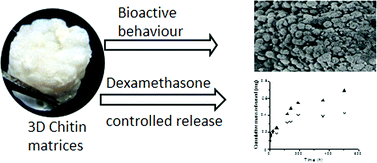Design and functionalization of chitin-based microsphere scaffolds
Abstract
Chitin agglomerated scaffolds were produced and functionalized using green chemistry principles and clean technologies. This combination enabled the functionalization of chitin microparticles prepared by dissolution of the polymer in ionic liquids, followed by the application of a sol–gel method. Finally, the 3D constructs were moulded and dried by a supercritical assisted agglomeration method. Structural and morphological characterization was performed using scanning electron microscopy (SEM) and micro-computed tomography (μ-CT). An evaluation of the bioactive behavior of the matrices was done by immersing them in simulated body fluid (SBF) for up to 21 days. The potential use of such matrices as drug delivery systems was evaluated after the incorporation of dexamethasone into the matrices during drying in supercritical assisted agglomeration. The findings suggested that the morphological features such as porosity, interconnectivity and pore size distribution of the matrices can be tuned by changing the particle size, chitin concentration and the pressure applied during moulding. Chitin microspheres were modified by siloxane and silanol groups, providing a bioactive behavior; the apatite formation was shown to be dependent on the amount and arrangement of silanol groups. Furthermore, in vitro drug release studies showed that dexamethasone was sustainably released. All these findings suggest that this strategy is a feasible and advantageous process to obtain chitin-based 3D structures with both functional and structural characteristics that make them suitable for regenerative medicine applications.


 Please wait while we load your content...
Please wait while we load your content...